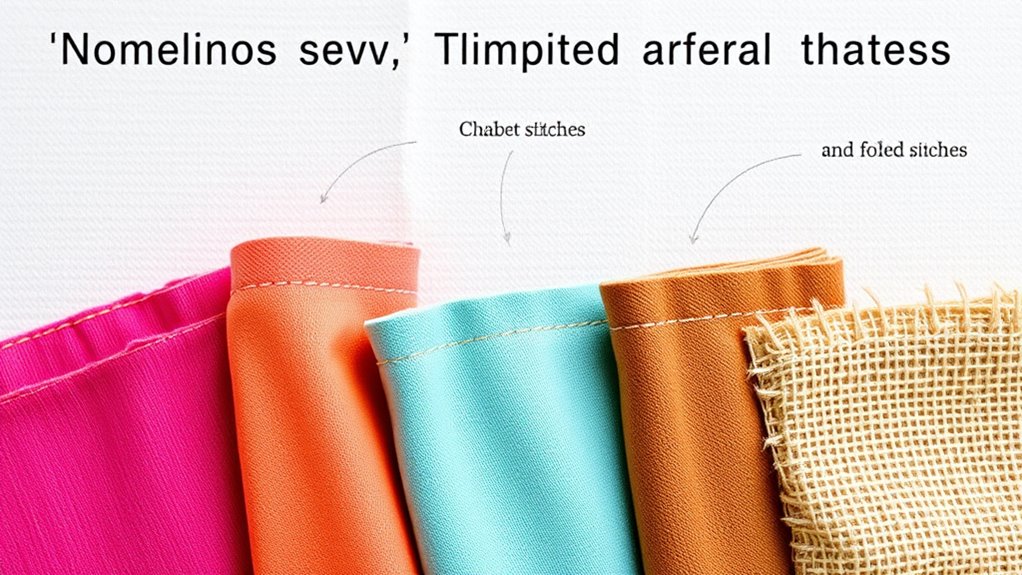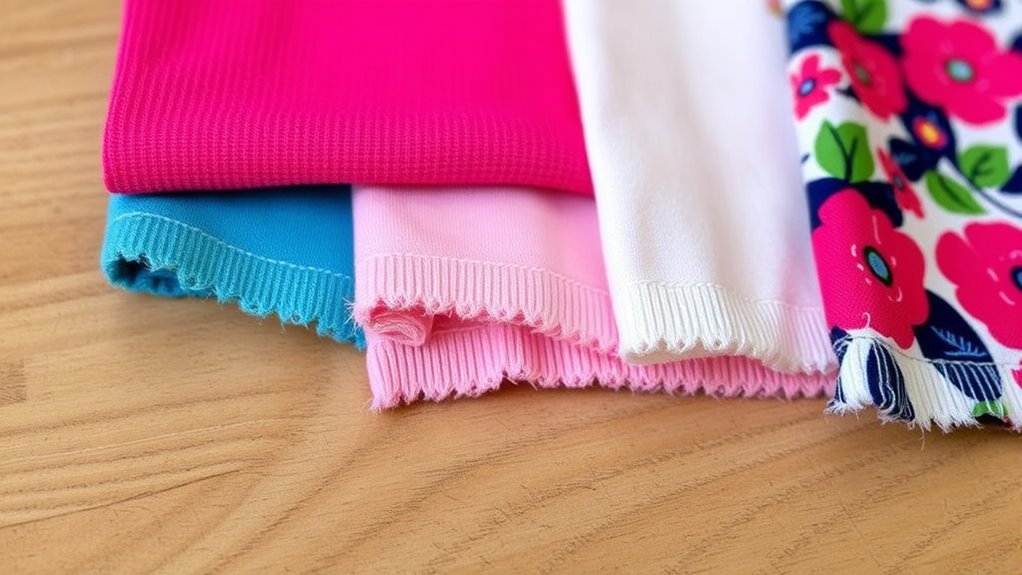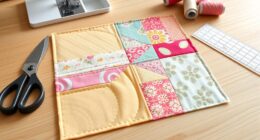To master no-sew hemming, use fabric or hemming tape and an iron to create secure, neat edges without sewing. Always test adhesives first on small fabric sections to prevent damage and achieve a professional look. Household items like double-sided tape, fabric glue, and an iron are all you need for quick fixes and customization. When you know these simple hacks, you’ll save time and effort — keep exploring for even more effective hemming tips.
Key Takeaways
- Use fabric glue or hem tape for quick, neat edges without sewing.
- Test adhesives on small fabric areas to prevent damage before applying.
- Secure fabric with double-sided tape or hemming tape before trimming for a clean finish.
- Activate iron-on hem tape with a household iron for strong, no-sew hems.
- Trim excess fabric carefully after securing to achieve a polished, professional look.

Whether you’re a beginner or an experienced crafter, these simple tricks can save you time and effort. No sewing required—just a few household items and a little creativity. One popular method involves using fabric glue or iron-on hem tape to secure the edges neatly. Additionally, applying personal debt forgiveness bills can help free up resources for your crafting supplies, making it easier to invest in high-quality materials. For a clean finish, consider using double-sided tape or hemming tape to hold the fabric in place before trimming. These hacks are perfect for quick repairs or customizing clothing and home decor. Remember to always test your adhesive on a small fabric area first to prevent damage. With these tips, you’ll be able to achieve professional-looking results without any sewing skills.
Frequently Asked Questions
Can No-Sew Hems Withstand Washing and Washing Machine Agitation?
You might wonder if no-sew hems can withstand washing and machine agitation. The answer depends on fabric durability and how securely you apply the no-sew method. Generally, high-quality fabrics with strong adhesive or heat-setting techniques offer better hemming longevity. However, delicate fabrics or weak adhesives may fray or loosen over time. To maximize durability, choose sturdy materials and follow proper application methods for the best results during washes.
What Fabrics Are Best Suited for No-Sew Hemming Techniques?
When choosing fabrics for no-sew hemming, you want ones with good fabric flexibility, which makes them easier to manipulate and reduces fraying. Lightweight cotton, fleece, and felt are excellent because they allow for more hemming precision without bulky seams. Avoid stiff or heavily textured fabrics, as they can be tricky to work with and may not hold the no-sew adhesive well. Picking the right fabric guarantees your no-sew hem stays neat and durable.
Are No-Sew Hem Hacks Suitable for Heavy or Thick Materials?
No-sew hem hacks aren’t ideal for heavy or thick materials due to fabric thickness, which can make adhering or folding difficult. These sewing alternatives work best with lighter fabrics that bend and stick easily. For thicker fabrics, you might need to think about traditional sewing methods or use specialized tools designed to handle fabric thickness. This ensures a clean, durable finish without the frustration that comes with trying no-sew techniques on heavy materials.
How Long Do No-Sew Hems Typically Last Compared to Traditional Hems?
Your no-sew hem lasts surprisingly long, almost like it’s glued in place! Generally, the hem’s longevity depends on the adhesive used and fabric type, but it might not match the durability of a traditional stitched hem. While no-sew hems are convenient and perfect for quick fixes, their durability comparison shows they tend to wear out faster over time, especially with frequent washing or heavy use.
Can No-Sew Hem Methods Be Easily Undone or Adjusted Later?
No-sew hem methods are generally not easily undone or adjusted later, which can limit your hemming flexibility. If you need to reapply fabric or modify the hem, it might be tricky without damaging the original work. For easier fabric reapplication or adjustments later, traditional hems are better, as they allow for more precise and flexible modifications. Keep this in mind if you think you might want to alter your hem in the future.
Conclusion
Now you’re equipped with nifty no-sew hem hacks to help you craft confidently. With quick tricks and clever cuts, you can conquer creases and customize cuffs without complications. Embrace these easy upgrades to elevate your projects effortlessly. Remember, mastering these maneuvers makes your sewing skills soar, so don’t delay—dazzle and daunt with daring, delightful DIY designs. Happy hemming and happy creating—your crafting confidence is just a hack away!









